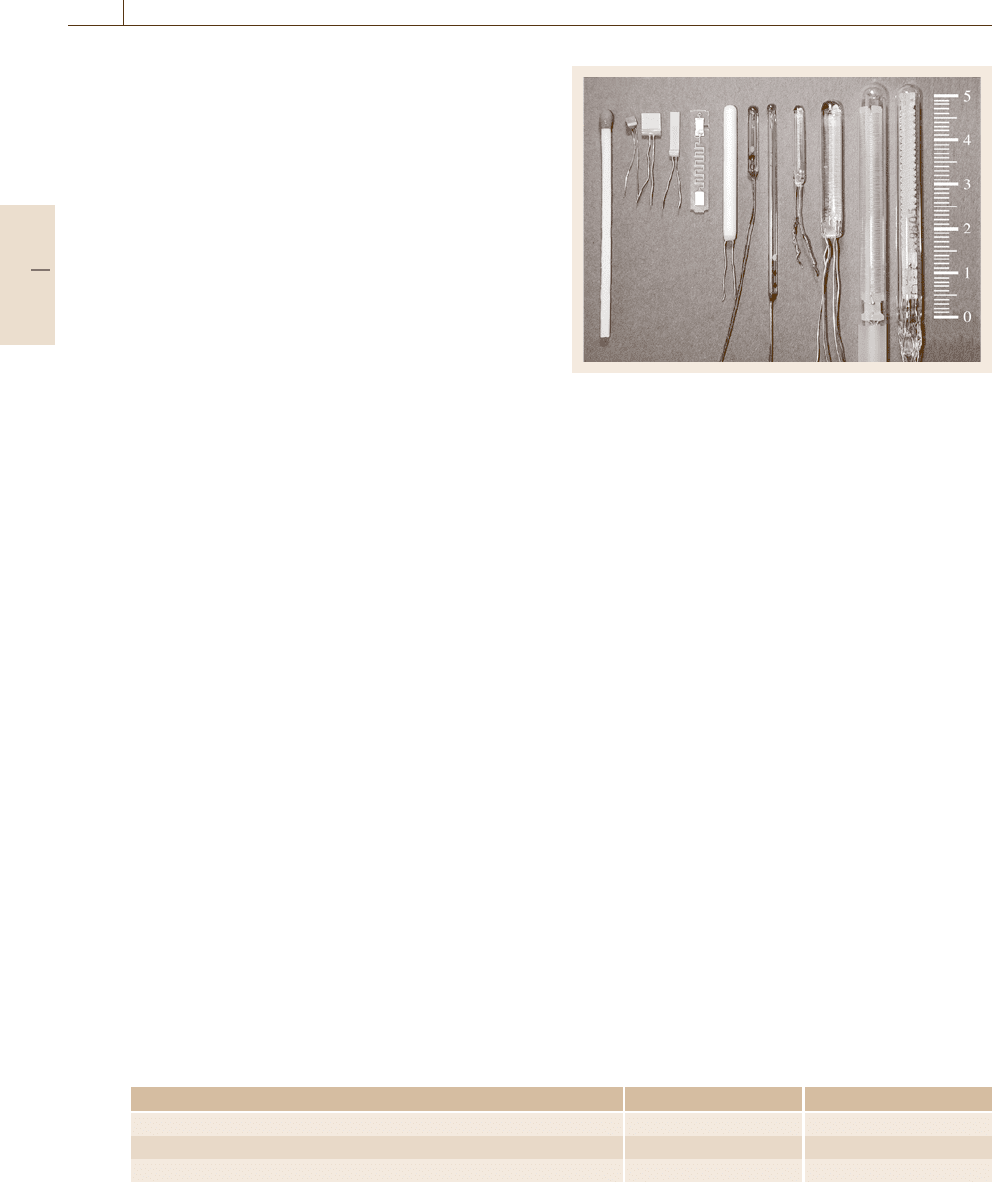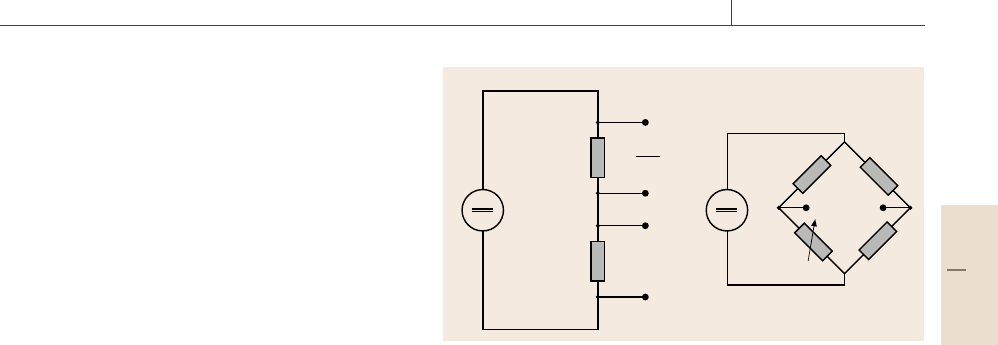Czichos H., Saito T., Smith L.E. (Eds.) Handbook of Metrology and Testing
Подождите немного. Документ загружается.


468 Part C Materials Properties Measurement
Adiabatic and some isoperibol instruments work
as heat-accumulation calorimeters, i. e. the heat to be
measured is detected via the temperature change of the
calorimeter. The calibration of the instrument is deter-
mined either by electrical calibration or by the use of
reference materials with well-known heat of solution,
reaction or adsorption.
A further method is to suppress the temperature
change by measuring the required compensating heat,
e.g. by means of electric energy (Joule heating or Peltier
cooling). In this case only a sensitive temperature sen-
sor (no calibration is required) with sufficient long-term
stability is needed because the calorimeter operates in
the isothermal mode. The thermometer is used only for
the control of the compensation power, so that the tem-
perature remains constant.
A third method of heat measurement is the deter-
mination of heat exchanged between the reaction vessel
and the (isothermal) surroundings by means of heat flux
sensors (Sect. 8.1.1). The vapor pressure of a mixture
depends on its composition. Heats of vaporization are
usually larger than heats of mixing. Therefore, the de-
termination and correction of the influence of the vapor
pressure change during the experiment is very impor-
tant. Measurement uncertainties of about 0.25% can be
achieved [8.30].
The advantages of continuously working flow
calorimeters [8.31] are that the measurements can be
carried out in a shorter period of time and that less
material is needed. Measurements of heat of mixing in
a temperature range of 273–479 K and a pressure range
between 0.1MPaand40.5 MPa with relative uncertain-
ties of 0.5% being possible [8.32].
8.2.5 Combustion Calorimetry
The most common device for measuring the heat of
combustion or calorific value of a solid or liquid ma-
terial is the bomb calorimeter [8.33–36].
A sample is contained under a pressure (about
3 MPa) of pure oxygen in a pressure-tight stainless-
steel container (bomb, V ≈ 300 ml) and is burned under
standardized conditions. During recent years several
new micro-bomb calorimeters (V < 100 ml) have been
developed. All instruments are provided with an elec-
trical system for the ignition of the combustion process.
The determination of the heat of combustion is based
on the observed temperature rise, which is measured
with high-precision temperature sensors such as stand-
ard platinum resistance thermometers, thermistors or
quartz thermometers. Adiabatic, isoperibol or aneroid
instruments are commercially available. In most cases
a correction of the measured temperature increase is
needed to consider the heat exchange with the sur-
rounding. Furthermore, the calibration factor (energy
equivalent) of the calorimeter must be determined. For
that purpose a reference material with a well-known
heat of combustion is needed. Benzoic acid is the pre-
ferred material for that purpose. With well-designed
bomb calorimeters relative measurement uncertainties
of less than 0.01% can be achieved [8.37] with highly
purified materials containing C, H, and O. If other elem-
ents are present, the accuracy is limited by the extent
to which the stoichiometry of the combustion process
can be controlled and determined. Systematic devia-
tions can arise from incomplete combustion or from the
lack of a well-defined final state.
Calorimeters for the determination of the calorific
value of gases can be subdivided into three different
groups [8.38]:
•
combustion of the gas inside of a bomb calorimeter
(isochoric combustion)
•
combustion without a flame on a catalyst (isobaric
combustion)
•
combustion of the gas in an open flame of a gas
burner (isobaric combustion)
The first two groups of methods are used only in rare
cases for very specific applications, e.g. investigations
on fluorochlorohydrocarbons.
Calorimetric methods in the third group are based
on the combustion of the gas at constant pressure and
flow rate (flow calorimeter) with an open flame. A heat
exchanger is used to transfer the combustion heat to
a heat-absorbing fluid (air or water). The temperature
increase of the heat-absorbing fluid is a measure of
the calorific value. For the calibration of these calorim-
eters various methods can be applied: the use of gases
with well-known calorific values, electrical calibration
techniques and methods based on the determination of
temperature increase, volume flows and the knowledge
of the heat capacity of the heat absorbing fluid. There
are several gas calorimeters commercially available,
e.g. the Junkers calorimeter, the Reinecke calorimeter,
the Thomas–Cambridge calorimeter, or the Cutler–
Hammer calorimeter. The typical relative measurement
uncertainty of these instruments is about 0.5%.
A high-precision constant-pressure gas-burning
calorimeter has been used for the determination of the
heat of combustion of methane [8.39]. The resulting
combined standard uncertainty was 0.21 kJ/mol which
corresponds to a relative uncertainty of 0.024%.
Part C 8.2

Thermal Properties 8.3 Thermal Expansion and Thermomechanical Analysis 469
8.3 Thermal Expansion and Thermomechanical Analysis
Thermomechanical analysis (TMA) measures the
change in dimension (deformation) of a sample under
constant (static force) compressive, tensile, or flexural
loads as the temperature of the sample is changed. The
special case with negligible force is called dilatometry
or thermodilatometry. Typical applications of TMA are
the determination of the coefficient of thermal expan-
sion, glass-transition temperatures, softening or shrink-
age behavior or the investigation of changes in dimen-
sion caused by sintering or chemical reactions. There
are several instruments commercially available covering
the temperature range between −260
◦
C and 2400
◦
C.
In dynamic mechanical analysis DMA a dynamic
force is applied to the sample and the resulting dis-
placement is measured as a function of temperature,
frequency or time. A special case is the application of an
oscillating force. Dynamic mechanical analysis is used
for the determination of the modulus of elasticity (stiff-
ness), viscous modulus and damping coefficient (tan δ)
of materials (for details see Chap. 7). In addition, DMA
measurements give insight into the temperature and fre-
quency dependence of molecular mobility and can be
used for the determination of glass-transition tempera-
tures.
Thermal expansion is the change of the length
of a specimen ΔL as a function of the temperature
change ΔT
ΔL = L −L
0
= L
0
αΔT . (8.17)
This behavior is described by the coefficient of (linear)
thermal expansion (CTE)
α =α
L
=
1
L
0
dL
dT
(8.18)
and is a function of temperature α = α(T ). The ref-
erence length L
0
of the specimen is generally given
either at a temperature of 0
◦
Corat20
◦
C. In crystalline
anisotropic solids the coefficient of thermal expansion
is direction dependent and may have up to six different
contributions.
The change of the volume of a body as a function of
temperature is described by the volumetric coefficient
of thermal expansion
α =α
V
=
1
V
0
dV
dT
. (8.19)
In most cases the volumetric coefficient of thermal ex-
pansion can be determined from the linear coefficient of
thermal expansion with sufficient accuracy by means of
α
V
≈3α
L
.
There are several different descriptions of thermal
expansion in use. In the definition according to (8.18)
α is often called the physical or differential coefficient
of thermal expansion. Furthermore, in some cases a so
called mean or technical coefficient of thermal expan-
sion according to
α
m
=
1
L
0
L(T
2
) −L(T
1
)
T
2
−T
1
=
1
L
0
ΔL
ΔT
(8.20)
is used. The third kind is the specification of a relative
length change ΔL/L
0
at a (mean) temperature T .
The coefficient of thermal expansion of a sample is
usually determined according to its definition (8.18)by
the measurement of the reference (initial) length L
0
at
the temperature T
0
, and the change of the length ΔL as
a result of a temperature change ΔT at different (mean)
temperatures.
The shape of the samples is typically a cylindrical
rod with a diameter in the rage 5–10 mm and a length
in the range 25–50 mm. Depending on the temperature
range of interest, cryostats, liquid baths, multizone or
heat pipe furnaces with excellent temperature stability
and homogeneity are used. These are operated either by
stepwise heating or by scanning at low rates. Thermo-
couples or radiation thermometers are mostly used for
the temperature measurements. More information can
be found in [8.40].
8.3.1 Optical Methods
For measurements of length changes with highest ac-
curacy, e.g., for the certification of reference materials,
for materials with very low coefficients of thermal ex-
pansion (Zerodur, Invar) and for cases when only small
samples are available, optical methods are chosen. Rel-
ative measurement uncertainties of the certified values
of α
L
of high-purity synthetic Al
2
O
3
of 0.18–1% were
achieved in a temperature range between −180
◦
Cand
+400
◦
C[8.41].
The optical methods can be divided into three main
types. The first one is based on the creation of an image
of a sample and the determination of the spatial move-
ment of the ends or other marks along the length. In
this case the optical path is perpendicular to the dis-
placement direction. The image is formed either by
background illumination to give a silhouette effect or
by the radiant light emitted from the specimen itself.
These techniques are known as optical imaging, optical
comparator or twin telemicroscopy.
Part C 8.3

470 Part C Materials Properties Measurement
The second type is based on interferometry. Here the
displacement is determined by the measurement of the
path difference of beams reflected from opposite sur-
faces of the sample. Because the refractive index of air
or inert gases is not known with sufficient accuracy most
measurements are carried out in vacuum.
In the third method speckle interferometry is used
to determine the displacement by means of changes in
the interference pattern on the surface of the sample.
There are further specialized techniques which do
not fall into the above categories. Details can be found
in [8.42].
For the certification of reference materials instru-
ments based on Fizeau and Michelson interferometers
have been used [8.43, 44]. At temperatures above
800 K several problems lead to a decrease in the accu-
racy of this method. Therefore, instruments based on
optical heterodyne interferometers for absolute meas-
urements at temperatures of 300–1300 K [8.45]and
1300–2000 K [8.46] have been developed. For meas-
urements with these instruments combined standard
uncertainties of 1.1×10
−8
K
−1
[0.26% for 100(Δα/α)]
at 900 K and of 1.3% in the range 1300–2000 K have
been claimed.
The highest accuracies are achieved around room
temperature. Measurement results on ceramic and steel
gauge blocks with uncertainties of 1 × 10
−9
K
−1
in
a temperature range between −10
◦
C and 60
◦
Chave
been published [8.47].
8.3.2 Push Rod Dilatometry
The most common method of measuring thermal ex-
pansion is push rod dilatometry. Several instruments
are commercially available for the temperature range
between −260
◦
C and 2800
◦
C.
A sample is heated in a furnace or other temper-
ature-controlled environment and the displacement of
the ends is mechanically transmitted to a displacement
sensor (e.g. a linear variable differential transformer,
(LVDT)) by means of push rods. There are several pos-
sible arrangements of the push rods. The first is the
parallel arrangement of two push rods, the double push
rod system. This arrangement can be modified by simul-
taneous use of sample and reference samples, known as
the differential method. A further arrangement is for one
of the rods to be in the form of a closed tube. The sam-
ple and the other push rod are located along the central
axis of the tube. In this case the sample is clamped be-
tween the central push rod and the closed end of the
other tube-shaped push rod.
The displacement sensor is maintained in a con-
trolled-temperature environment close to room tem-
perature. Therefore, the most critical part is the push
rod, which transmits the expansion signal from the
sample to the displacement sensor. The resulting tem-
perature difference between opposite ends of push rods
can be more than 2000 K. Therefore, the homogeneity
of the temperature field in the furnace, the repeatabil-
ity of a temperature program and the material used for
the push rods are of critical importance for high-quality
measurements.
The main criterion for the choice of a material used
for push rods is a low, reproducible, and accurately
known coefficient of thermal expansion. At low tem-
peratures vitreous silica is the preferred material. There
are very different recommendations for the upper tem-
perature for the use of vitreous silica for this purpose,
ranging from the temperature of the α–β transition of
about 550
◦
C to 1000
◦
C as the maximum tempera-
ture to avoid devitrification, i. e. the transition from the
glassy state to a crystalline structure. For temperatures
up to 1600
◦
C push rods are made from silica, either
in single-crystal form (sapphire) or sintered (polycrys-
talline) state, at higher temperatures rods consisting of
isotropic graphite are used.
Dilatometers are often operated in a dynamic mode
by temperature scanning with a constant rate of typ-
ically less than 5 K/min. Depending on the method
of construction more than one measurement may be
necessary to determine the correction for the ther-
mal expansion of the push rods and to calibrate both
the displacement- and the temperature sensor. For this
purpose certified reference materials are necessary.
High-purity materials such as silicon, tungsten, plat-
inum, copper, aluminum, sapphire or vitreous silica
are mostly used for displacement calibration. The cal-
ibration of the temperature sensor is carried out by
the measurement of the dimensional change of a high-
purity metal during melting.
With careful work relative measurement uncertain-
ties for the CTE of 2% at temperatures between room
temperature and 973
◦
C have been achieved [8.48].
8.3.3 Thermomechanical Analysis
The basic difference between thermomechanical analy-
sis (TMA) and dilatometry is that for TMA a load (static
force) is applied to the sample. As a consequence in-
struments for TMA are operated with vertical sample
orientation. This is different from most dilatometers,
where horizontal sample and furnace orientation is cho-
Part C 8.3

Thermal Properties 8.5 Temperature Sensors 471
sen as this gives better temperature uniformity. There
are several modes of force control and sample con-
figuration for TMA. At negligible load the thermal
expansion measurements are carried out in a very sim-
ilar manner to dilatometry. In the compression mode
a rod with well-known cross section or geometry
presses with a known force on the sample and the
compression, penetration or bending is determined as
a function of force, temperature or time. From these
kinds of measurements elastic modulus, creep or cure
behavior, softening temperatures or phase transition are
determined. This is also of advantage for the inves-
tigation of transitions in thin films such as polymer
coatings or lacquers. Further applications are measure-
ments in tension mode and investigations of the viscous
properties or gelation of fluids. There are instruments
commercially available for a temperature range between
−160
◦
C and 2400
◦
C.
8.4 Thermogravimetry
Thermogravimetry (TG) is a method of thermal analysis
in which the mass of a sample is measured as a func-
tion of temperature whilst the sample is subjected to
a controlled temperature program. In many cases the
reaction products are analyzed by supplementary inves-
tigations. As for most other methods of thermal analysis
the typical temperature program is a linear scan, i. e.
the temperature changes linearly in time. During re-
cent years so called controlled-rate thermal analysis
has been increasingly used. This means that the scan-
ning rate can vary as a function of time depending on
the magnitude of the measured quantity; for example,
the scanning rate of a thermogravimetric instrument is
controlled as a function of the measured mass change
of the sample or the amount of a specific evolved
gas.
Typical applications are the evaluation of the ther-
mal decomposition kinetics of materials such as rubbers
or polymers, the investigation of processes such as sin-
tering, drying, oxidation or reduction. There are several
instruments for investigations in a temperature range
between −150
◦
C and 2400
◦
C commercially available.
Typical sample masses are in the range 5–25 mg. Mass
changes can be detected with resolutions in the range
0.1–10μg. Most TG instruments can be combined
with calorimetric detection systems for simultaneous
differential thermal analysis or differential scanning
calorimetry. Thermogravimetry is performed in a con-
trolled atmosphere including oxygen, nitrogen, helium
or argon with adjustable flow rates.
A mass spectrometer (MS)oraFourier-transform
infrared (FTIR) spectrometer can be coupled to most
TG instruments for continuous, online identification
and analysis of the evolved gases during heating of the
sample. To avoid a separation or loss of evolved gases
by condensation these are routed to the MS via a heated
capillary or a system of orifices held at the same tem-
perature as the sample (Skimmer coupling).
A recent extension of TG systems is pulse ther-
mal analysis [8.49]. This is based on the injection of
a specific amount of liquid or gaseous reactant into the
inert carrier gas stream and monitoring of the changes
in the mass, enthalpy, and/or gas composition. By this
method gas–solid reactions, adsorption or catalytic pro-
cesses can be studied. A further application is the direct
calibration of the mass spectrometer or FTIR spectrom-
eter by injecting a known amount of substance into the
inert carrier gas stream and relating it to the spectrom-
eter signal. For more information the reader is referred
to [8.50].
8.5 Temperature Sensors
Temperature sensors are needed for the measurement
of thermal properties of materials, of course, but they
are used in a much larger field of applications, since
temperature is the quantity measured most frequently in
science, industry, and daily life. In the following chapter
a selected number of temperature sensors of sufficient
reliability for scientific and industrial measurements is
described as well as the temperature scale against which
they should be calibrated.
8.5.1 Temperature and Temperature Scale
Temperature characterizes the thermal state of matter
independently of the nature of the substance. It is an
intensive quantity, not depending on the addition or re-
duction of the amount of matter concerned, but changed
by supplying or removing heat or mechanical work.
Classically, the definition of temperature is derived from
the thermodynamic description of a Carnot engine re-
Part C 8.5

472 Part C Materials Properties Measurement
versibly driven in a thermodynamic cycle, the efficiency
of which depends only on temperature. The ratio of the
heat Q
1
fed to the engine isothermally at high temper-
ature to the heat Q
2
removed at low temperature to get
back mechanical work was found to be identical to the
ratio of the temperatures T
1
and T
2
at both isothermal
parts of the cycle by William Thomson, the later Lord
Kelvin:
Q
1
/Q
2
= T
1
/T
2
. (8.21)
From this definition of temperature he could derive the
equation of state for an ideal gas to be
pV = const T . (8.22)
This states that the product of the gas pressure p and
the volume V filled with the gas is proportional to the
absolute temperature. The constant in (8.22) turned out
to be equal to nR, the product of the number n of moles
involved and the gas constant R.
By statistical methods it was shown during the sec-
ond half of the 19th century that the average kinetic
energy of a molecule of an ideal gas amounts to
pV = const
mv
2
/2
, (8.23)
Table 8.3 Primary thermometers and the fundamental relations on which they are based
Thermometer Fundamental relation
Constant-volume gas thermometer (ideal gas)
pressure p, volume V , number of moles n, molar gas constant R,
temperature T
pV = nRT
Acoustic gas thermometer (ideal gas)
speed of sound c
s
, ratio γ of specific heat capacities
at constant pressure and constant volume, gas constant R,
temperature T ,molarmassM
c
s
=(γ RT/M)
1/2
Dielectric-constant gas thermometer (ideal gas)
pressure p, Boltzmann constant k
B
, temperature T ,
dielectric constant ε, electric constant ε
0
,
static electric dipole polarisability of
a gas atom α
0
p =k
B
T(ε −ε
0
)/α
0
(Clausius–Mosotti equation)
Total radiation thermometer
total radiance L, Boltzmann constant k
B
, temperature T , speed of
light in vacuum c, Planck constant h
L =
2π
5
k
4
B
T
4
/
15c
2
h
3
(Stefan–Boltzmann law)
Spectral band radiation thermometer
spectral radiance L
ν
, Planck constant h, frequency of light in
vacuum ν, speed of light in vacuum c, Boltzmann constant k
B
,
temperature T
L
ν
= 2hν
3
/c
2
[exp(hν/k
B
T ) − 1]
−1
(Planck’s Law)
Noise thermometer
mean square noise voltage
V
2
, Boltzmann constant k
B
, temperature
T, resistance R, bandwidth Δ f
V
2
=4k
B
TRΔ f
(Nyquist formula)
a fact, which demonstrates that temperature is a measure
of the averaged internal energy of the gas molecules,
which are ascribed a mass m and a velocity v.
An apparatus built to determine the pressure and
the volume of a known number of moles of an ideal
gas can be used to measure the temperature of the
gas according to (8.22). Such a gas thermometer is
called a primary thermometer, since there is no need
to calibrate it against another thermometer and it is
based on a fundamental physical law including the
thermodynamic temperature. There are several other
primary thermometers based on different fundamental
laws listed in Table 8.3.
Since these primary thermometers are usually com-
plicated and difficult to handle, a temperature scale was
introduced for practical purpose and refined over the
years. Such a scale consists of temperature fixed points,
the temperature values of which are determined with
great effort by comparison with primary thermometers,
and of interpolating instruments, which are calibrated
at those fixed points and define the temperature in be-
tween. After some early attempts such a scale was
adopted in 1927 following a suggestion by Callendar
Part C 8.5

Thermal Properties 8.5 Temperature Sensors 473
from 1899. The actual revision of the temperature scale
dates from 1990. It is called the International Temper-
ature Scale of 1990, ITS-90. It is based on 14 fixed
points from the triple point of hydrogen (13.8033 K) to
the freezing point of copper (1357.77 K) and the vapor
pressure of the stable helium isotopes below.
One of these fixed points is the triple point of water,
the value of which is fixed to 273.16 K, as the defin-
ing point of the temperature unit kelvin. This definition
states: the kelvin is the fraction 1/273.16 of the thermo-
dynamic temperature of the triple point of water.
Interpolating instruments are the vapor pressure
thermometer with
3
He or
4
He as the working gas from
0.65 K to 5 K, which is part of the scale’s definition as
well, an interpolating gas thermometer with the same
gases up to 25 K and standard platinum resistance ther-
mometers (SPRTs) above. From the freezing point of
silver (1234.93 K) to the highest temperatures to be
reached the relative spectral radiance thermometer is
used, being calibrated at the Ag, Au or Cu fixed point,
respectively. Table 8.4 includes the temperature fixed
points and indicates the uncertainty ΔT
90
of the real-
ization of the ITS-90.
In 2000 the CIPM (Comité International des Poids
et Mesures) adopted an extrapolation of the tem-
perature scale to subkelvin temperatures. This scale,
called the Provisional Low Temperature Scale of 2000,
PLTS-2000, is based on magnetic and superfluid phase
Table 8.4 The defining fixed points of ITS-90 (after [8.51])
No. T
90
(K) t
90
(
◦
C) T
90
(mK) Substance State
1 3–5 −270.15 to −268.15 0.1
3
He and
4
He Vapor pressure
2 13.8033 −259.3467 0.1 e-H
2
a
Triple point
3 ≈17 ≈−256.15 0.2 e-H
2
Vapor pressure ≈33.3213 kPa
4 ≈20.3 ≈−252.85 0.2 e-H
2
Vapor pressure ≈101.292 kPa
5 24.5561 −248.5939 0.2 Ne Triple point
6 54.3584 −218.7916 0.1 O
2
Triple point
7 83.8058 −189.3442 0.1 Ar Triple point
8 234.3156 −38.8344 0.05 Hg Triple point
9 273.16 0.01 0.02 H
2
O Triple point
10 302.9146 29.7646 0.05 Ga Melting point
11 429.7485 156.5985 0.1 In Freezing point
12 505.078 231.928 0.1 Sn Freezing point
13 692.677 419.527 0.1 Zn Freezing point
14 933.473 660.323 0.3 Al Freezing point
15 1234.93 961.78 1–10 Ag Freezing point
16 1337.33 1064.18 10 Au Freezing point
17 1357.77 1084.62 15 Cu Freezing point
a
e-H
2
is hydrogen at the equilibrium concentration of the ortho and para molecular forms
transitions in
3
He and the minimum of its melting
pressure as fixed points and the
3
He melting curve ther-
mometer as the interpolating instrument.
The national metrological systems, often divided
into legal and industrial branches, provide national tem-
perature standards and calibration facilities for science
and industry to trace back the readings of thermometers
of individual users. The lowest uncertainty is avail-
able from those national metrological institutes, which
compare their particular representations of ITS-90 from
time to time by means of so called key comparisons to
guarantee the uniformity of temperature measurements
throughout the world. The definition of temperature, the
development of temperature scales and the principles
of thermometry are extensively explained in the mono-
graph [8.52].
Very recently, efforts have been started by several
national metrological institutes to replace the depen-
dence of the kelvin on a material property, namely the
already mentioned triple point of water. Instead, it is
suggested that the kelvin should be based on a funda-
mental constant as is done with other SI units, which
are already related to a fundamental constant, such as
the meter to the speed of light in vacuum, or are in
the process of being related, like the kilogram. In the
case of the kelvin the appropriate constant would be the
Boltzmann constant k
B
. If its value is determined with
sufficient accuracy – about one order of magnitude bet-
Part C 8.5

474 Part C Materials Properties Measurement
ter than now – and then fixed by definition, temperature
could be traced back to the internal energy k
B
T,the
quantity to which it is proportional in the microscopic
view, as mentioned at the beginning of this section.
8.5.2 Use of Thermometers
Strictly speaking, a thermometer never measures the
temperature of the sample of interest, but always its
own. To get an indication of the sample’s temperature
its temperature and the temperature of the thermometer
should agree within the requested uncertainty of the
measurement. To meet this requirement within a finite
amount of time heat should easily be able to flow be-
tween them. If the heat flow has approached zero, so
called thermal equilibrium is reached between sample
and thermometer, and the thermometer is ready to in-
dicate the sample’s temperature. In the case of contact
thermometry the thermal resistance between the sample
and the thermometer should be low. Thermal conduc-
tivity should be high within the sample and within
the thermometer to provide thermal equilibrium within
both. A small heat capacity of the thermometer is advan-
tageous, since then only a small amount of heat is forced
to flow in order to reach thermal equilibrium. Small
heat capacity, good thermal contact and large internal
thermal conductivity make the thermometer fast.
A thermometer gives an indication of its tempera-
ture by measuring some other property that is somehow
dependent on temperature. With a constant-volume gas
thermometer the pressure is the quantity that measures
temperature, with a resistance thermometer it is the
electrical resistance of the sensor. Usually some en-
ergy is needed to read the thermometer on the display.
This energy is fed to the sensor and, in principle, due
to the permanent heat flow, keeps the thermometer out
of equilibrium. Therefore, the measuring energy must
be reduced to a value that does not disturb the result.
Since thermal conductivity, thermal contact resistance
and heat capacity change with temperature, the measur-
ing energy must also be changed in most cases over the
temperature range.
In the following, we will consider some frequently
appearing errors in the use of thermometers, which are
discussed in [8.53] in great detail.
•
Electromagnetic interference
Since the energy flowing between sample and ther-
mometer is not limited to the measuring energy,
other energy contributions coupled into the sys-
tem, such as heat leaks, must be kept under control
during the measurement. If electromagnetic energy
from radio and television broadcasts irradiates the
thermometer and is fed in by the wiring, or if
the electromagnetic radiation emitted from hot sur-
faces nearby is absorbed by the thermometer, the
measuring result can be significantly affected. Elec-
tromagnetic shielding of the thermometric sensors
and electronics, filtering circuits in the sensor wiring
and radiation shields are necessary tools when the
amount of irradiated external energy can not be
tolerated. In extreme situations the whole measure-
ment should be located in an electromagnetically
shielded room.
•
Immersion error
Immersion error is an issue for liquid-in-glass ther-
mometers and others that are usually not fully
immersed in the liquid to be measured. In this case,
heat is permanently flowing through the stem of
the thermometer from the bath to the surrounding
air. This is a typical nonequilibrium situation inap-
propriate for an exact result. As a rule of thumb
a thermometer should be immersed into the bath
by more than ten diameters of the thermometer
(that means 40 mm beyond the sensing element with
a sensor diameter of 4 mm) to limit the error to
0.01%.
•
Heat capacity error
If the heat capacity of the thermometer is not neg-
ligible compared to the heat capacity of the sample
and the sample is more or less thermally isolated,
a certain amount of heat flows between them when
the starting temperatures are different. After reach-
ing thermal equilibrium both temperatures have
changed to a common value somewhere between
their initial temperatures. This means that, if the
sample’s temperature was, e.g. much hotter than that
of the thermometer, the finally indicated tempera-
ture of the sample would be less than its value before
the measurement. This difference is called the heat
capacity error.
•
Time constant
Even if the sample’s heat capacity is large enough
to avoid the heat capacity error it may take a signif-
icant time to replace the heat in the sample that has
flown into the thermometer while thermal equilib-
rium was established. Therefore, the reading of the
thermometer approaches its final value following an
exponential trend with a time constant τ
0
. If insuffi-
cient time is given to the system, a settling response
error is arising. If the temperature of a sample is
changing at a certain rate, and the settling rate of
Part C 8.5

Thermal Properties 8.5 Temperature Sensors 475
the thermometer is too slow compared to the tem-
perature variation rate, a lag between the real and
the measured temperature will develop. This can be
avoided either by slowing down the rate of tempera-
ture change or by a constructive improvement of the
thermal coupling between the parts of the system.
•
Environmental irradiation
According to the Stefan–Boltzmann law (see Ta-
ble 8.3) all material surfaces emit electromagnetic
radiation proportional to T
4
. Therefore, all radiat-
ing sources in the environment should be removed,
if possible, or at least shielded, since thermometers
should not see surfaces at temperatures very differ-
ent from their own. In addition, thermometers show
significantly different readings up to the order of
some kelvin depending on their surface emissivity.
This fact recommends proper shielding, as well.
To clarify the different influences on thermometers
during the measurement of temperature it is helpful to
use analogue electrical modeling. Since thermal con-
ductivity can be described in a similar way as its
electrical correspondent, one can derive analogue re-
lations. Heat Q corresponds to electrical charge Q
el
,
heat flux q to electrical current I, temperature dif-
ference ΔT to voltage V, thermal resistance R
th
to
electrical resistance R
el
, and heat capacity c
p
to elec-
trical capacitance C. Thus, Ohm’s law can be applied in
analogy to heat flow processes in the following form:
ΔT = T
2
−T
1
=qR
th
. (8.24)
If the heat flow crosses several materials with different
thermal conductivities and thermal contact resistances
in between, the thermal resistances can be added like
electrical resistances in series. If there are several heat
flows from different sources to one thermometer, such
as heat conduction from the sample and from the sur-
roundings and thermal radiation from other nearby
objects, the inverse of the thermal resistances can be
added again. Within this electrical analogue picture one
can state that a thermometer measures the correct sam-
ple temperature when the thermal resistance between
them goes to zero, whereas the thermal resistances to
other objects such as the surroundings tend to infinity
by screening or shielding measures.
If temperature measurements are performed in
a way that excludes all errors, most of which are men-
tioned above, the result is reliable only with the correct
calibration of the instrument. This means, that its in-
dicated result must be traced to the SI unit kelvin by
linking it to the international temperature scale. Further-
more, the uncertainty of the calibration caused by the
number of steps or the special way of this trace back
must be known or investigated, and the reliability of
the instrument over a longer period of time should be
proven. The last requirement can be met by repeated
calibrations from time to time, depending on the fre-
quency and intensity of the thermometer’s use.
8.5.3 Resistance Thermometers
The type of thermometers most frequently found in
scientific and technical equipment is the resistance ther-
mometer, since it is easily read by electronics and can
simply be used for temperature control cycles. The most
widespread type among the resistance thermometers is
the platinum resistance thermometer, which at the same
time is the interpolating instrument of the ITS-90 at the
highest level of accuracy. In the latter case it is called the
standard platinum resistance thermometer (SPRT)and
is used in different forms between the triple point of hy-
drogen at 13.8033 K and the freezing point of silver at
1234.93 K.
The electrical resistance of metallic samples comes
from the scattering of the conduction electrons at
the atoms or molecules of the solid lattice. There is
a temperature-dependent part of the resistance R
t
due
to lattice vibrations, which increases with increasing in-
ternal energy, and a temperature-independent part R
0
caused by impurities and by lattice defects. The total
sample resistance arises as the sum of both
R(T ) = R
t
(T )+ R
0
. (8.25)
This equation, in the literature called Mathiessens’s
rule, can be reformulated as
R(T ) = R(0
◦
C)(1+αt) , (8.26)
where α is the temperature coefficient of resistance.
Fewer impurities or defects reduce R
0
or R at 0
◦
Cand
increase α. Therefore, the metals that should be used for
resistance thermometers are those that can be purified
to the highest values and effectively annealed. High-
purity platinum most closely obeys Mathiessen’s rule
with small deviations found by Callendar and later by
van Dusen. Finally, (8.26) is modified to the Callendar–
van Dusen equation
R(T ) = R(0
◦
C)
1 + At +Bt
2
+C(t −100)t
3
,
(8.27)
with coefficients of the order: A = 4×10
−3 ◦
C
−1
,
B =−6×10
−7 ◦
C
−2
,andC = 4×10
−12 ◦
C
−3
.
Part C 8.5

476 Part C Materials Properties Measurement
This ideal behavior of platinum thermometers is
only true, if no other effects influence its resistance.
Such disturbing effects to be avoided are strain, mech-
anical shock, vibration, pressure, humidity, and corro-
sion. Some of them, such as strain, are caused by tem-
perature changes in an uncontrolled manner. Others can
be reduced by careful handling. Further ones must be
minimized by using a sealed and shielded construction.
Standard platinum resistance thermometers for ITS-
90 realization are manufactured in three different types,
as listed in Table 8.5.
SPRTs are usually constructed of high-purity coiled
platinum wire within a sheath of glass or quartz em-
bedded in a platinum tube. This is a setup free of strain
and danger of contamination, but extremely sensitive to
shock, vibrations or other mechanical stress. Therefore,
SPRTs are, on one hand, temperature standards with
high stability and an uncertainty of less than 1 mK, but
on the other not suitable for rough industrial environ-
ments. To obtain a more robust device, the support of
the platinum wire should be improved. This inevitably
causes more strain during temperature variations and
increases the uncertainty to about 10 mK. A further dis-
advantage of all wire-made devices is the poor thermal
contact only made by the gas in the capsule and the
leads, resulting in time constants of several seconds.
As an alternative solution, thick-film thermometers are
available, which can be glued to the sample of interest
and have improved thermal contact and time constant.
They mostly have a nominal resistance of 100 Ω and
are well suited as sensors for rough environments and
temperature control circuits, but they feel much more
strain and contamination effects and suffer from a larger
uncertainty of about 100 mK. All of these devices are
available commercially and should not be fabricated by
the user except for very special needs. Some of them are
showninFig.8.10.
For the electronics of resistance thermometers two
different concepts are in use: the potentiometric method
and the resistance bridge (Fig. 8.11). The first is the
most common concept, especially since precise elec-
tronic devices appeared on the market. A reference
resistor is placed in series with the temperature sen-
sor and the voltage drop across each of the resistors
Table 8.5 Types of standard platinum resistance thermometers
Type of thermometer Temperature range Typical resistance
Capsule thermometers, 50–60 mm long 13.8–430 K 25.5 Ω
Long-stem thermometers, 450 mm long 84–933 K 25.5 Ω
High-temperature long-stem thermometers 0.01–962
◦
C 0.25 Ω
Fig. 8.10 (from left to right) three thick-film Pt-100 re-
sistors; Pt-500 chip resistor prepared for SMD mounting;
Pt-100 resistor in ceramics; two NTC thermistors in glass;
Pt-100 resistor in glass; double Pt-100 resistors in glass;
long-stem SPRT (Pt-25); capsule SPRT (Pt-25)
is determined when a constant current is applied. The
voltage drop across the known reference resistor R
ref
yields the current I through the sensor. Using the
voltage drop V (T ) measured across the sensor, the re-
sistance R(T ) can be calculated using Ohm’s law again.
The use of bridge circuits is an alternative method.
These circuits rely on the principle of the Wheatstone
bridge. The design consists of two parallel branches of
two resistors in series, e.g. R
1
and the sensor R(T )in
one branch and R
2
and R
3
in the other. In the balanced
bridge mode, the resistor R
3
is adjusted so that the volt-
age between the centers of the two branches is zero.
This adjustment has to be done for each temperature T.
R(T )isthengivenby
R(T ) = R
1
R
3
/R
2
. (8.28)
If this balancing is performed at only one temperature,
say T
0
, the bridge output V
1
−V
2
differs from zero at
other temperatures and is proportional to the measured
temperature in the linear range of the bridge around T
0
.
When measuring the temperature sensor’s resis-
tance one has to consider that there always is a lead
resistance in series. The best method to avoid this error
is to measure with a four-lead arrangement, where the
Part C 8.5

Thermal Properties 8.5 Temperature Sensors 477
two voltage probe leads are fixed as close to the sensor
as possible. If the voltmeter’s internal resistance is close
to infinity, only a negligible current flows through the
voltage leads and their voltage drop can be neglected. If
four leads are too expensive and less accuracy is suf-
ficient, a two-lead arrangement can be used. For the
lead wires, materials with a low temperature coefficient
of electrical resistance are preferred. Furthermore, the
wiring should be performed such that the temperature
along these leads will not change during the measure-
ment to keep their resistance constant. There is also
a third method, which is a sort of compromise in ex-
pense and accuracy between both methods described:
the three-lead concept. Here only one voltage lead is
connected close to the sensor. Thus, one can measure
the voltage drop across the sensor and one current lead
in series and subtract the voltage drop of the other cur-
rent lead measured separately.
There are further sources of errors not dealt with
up to now, the thermoelectric effect at connections of
different materials along the leads and the input off-
set voltage of the voltmeter. By reversing the direction
of the measuring current those errors can be averaged
out. If this is done systematically by applying alternat-
ing current for the measurement, one can remove these
errors quantitatively. In addition, the resolution of the
measurement can be improved by the application of
lock-in techniques.
Electromagnetic interference (EMI) can be a prob-
lem in particular with alternating current (AC) mea-
surements, if the filtering of, e.g., the power lines is
not adequate in the electronics. In addition, the sensor
leads should be protected from extra currents induced
by changing external magnetic fields. This could be
achieved using the twisted-pair design or by coaxial ca-
ble to minimize the loop area between the lead wires.
The heating of the sensor by captured radio and tele-
vision frequencies should be prevented by appropriate
shielding of the whole measuring arrangement. Other
errors are primarily due to the handling of the measure-
ment and the methods of avoiding these are described
in the previous section.
A different type of resistance thermometer is the
rhodium–iron thermometer (0.5% Fe in Rh). Its mer-
its are at the low temperature range between 0.5K and
30 K, where it is more sensitive than the platinum ther-
mometer, but it is still useful up to room temperature.
Besides the wire-type device with a resistance in the
range 20–50 Ω, thick-film versions are commercially
available. For very low temperatures different resistance
materials are used and described in the last section.
a) b)
R
ref
I =
R
ref
V
ref
R(T) V(T) = R(T)×I
R
2
R
1
R
3
R(T)
V
1
–V
2
= 0
V
1
V
2
Fig. 8.11a,b Resistance measurement circuits (a) potentiometric
type. (b) bridge type
There are also resistance thermometers made from
semiconducting materials, known as negative temper-
ature coefficient (NTC) or positive temperature coeffi-
cient (PTC) thermistors. The temperature dependence
of the resistance of NTCs obeys an exponential law
R(T ) = A exp(B/T ) . (8.29)
Compared to platinum resistance thermometers, NTCs
show more than 100 times the sensitivity (3–6%/
◦
C) in
the temperature range from −100
◦
Cto+150
◦
Caswell
as being smaller and faster. Two such devices are shown
in Fig. 8.10. However, they are significantly less stable
than PRTs and their temperature resistance relation is
extremely nonlinear (8.29) and difficult to fit accurately
over a wide range. They are ideal for use in control
circuits and for differential temperature measurements.
8.5.4 Liquid-in-Glass Thermometers
A liquid-in-glass thermometer, the oldest type of ther-
mometer, is based on the thermal expansion of a liquid
as a function of temperature. It consists of a glass bulb
connected to a capillary containing the sensing liquid
– in most cases mercury or an organic liquid. Attached
to it is a scale scratched on a flat glass strip along the
capillary or on the capillary itself. The bulb, capillary,
and scale are placed in a slightly wider glass tube as
a protective container.
In spite of the image of simplicity that liquid-
in-glass thermometers have obtained, they are more
complicated to understand and to handle than is com-
monly recognized. Such a thermometer is a system
with strong interference between its components. The
liquid is the temperature sensor and its indicator at
the same time, which means that the volume of the
Part C 8.5
